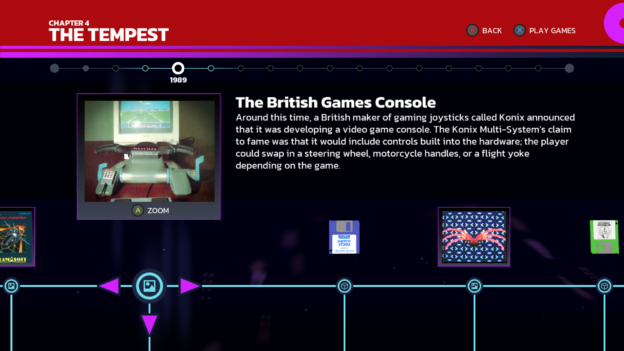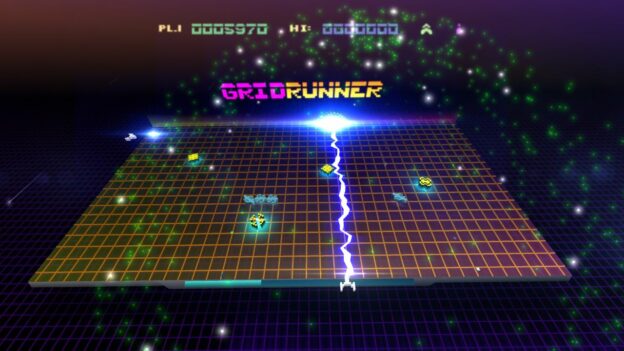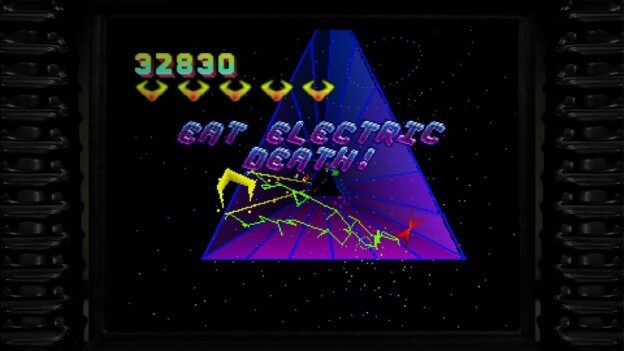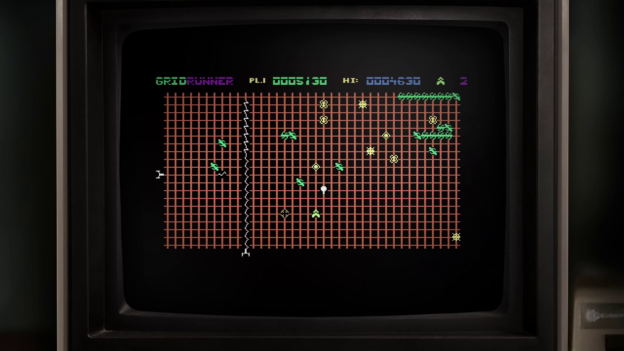The latest in Digital Eclipse’s “Gold Master series,” Llamasoft The Jeff Minter Story, contains much of what fans have come to expect: an interactive timeline packed with cool videos that excel more in this format than they ever could on YouTube, plenty of candid history showing not only the growth of the developer in question but also of the industry as a whole, and, of course, numerous games to test your thumbs. It’s a good collection, kept from “great” territory by only telling a small portion of Minter’s story.
As a U.S. gamer, I mainly knew Minter for his habit of attaching himself to unpopular hardware like the Atari Jaguar and VM Labs Nuon (yes, Trev owned both). So, I was curious to experience some of his other work with U.K. computers firsthand. Taken as a truncated bit of gaming history that gives access to lesser-known and/or harder-to-find works, this package is a success.
With over 40 games, there’s no possibility of covering even a quarter of them within the confines of a traditional review. This is okay, especially in this case, as there’s a real sense this collection is more focused on Minter as a person (for better or worse) than his actual software. As such, it should hold extra appeal for existing fans of the Yak.
As for most of these games, they leave me with a sense of “you had to be there.” They are dated and thus show their age. Yet, as products of their time, I did get some entertainment from viewing these through the lens of the early ’80s, a period I was too young to remember. A lot of these are takes on games that were popular at the time. Some feel too similar (ports excluded), some too slow, others too fast. Even Minter is humble enough to admit that some of his early games missed the mark in development time, difficulty curve, speed, and other areas.
I’ll highlight a few of my favorites. Note that plenty of the games in this collection live up to the company name, with llamas and other furry creatures copiously featured. In fact, the quote to open this package says, “If you load up one of my games and see a big camel or whatever, you know immediately who has created it – I’ve always tried to put a bit of myself into my games.”
Laser Zone (whose llamas are limited to the title screen) is a 1983 shooter that succeeds by being more intuitive and less complex, though still challenging to master. You control a pair of cannons, one on a horizontal plane and the other on a vertical, and must change between them to eliminate the advancing aliens. Two versions are in this package.
Meta-llamas has some similarities to Laser Zone, and not just because it’s also an ’83 shooter with two versions in this package. Left or right controls your llama, while up and down controls the force field above. Ricochet your shots successfully.
Colourspace is an early Llamasoft light synthesizer with nearly a dozen head-bobbing music tracks to enjoy. The demo mode is a fun enough watch, but the amount of control the player is given over what they can see is admirable and helps promote replay value. Adjust the speed, alter the colors, and more. Just be careful if you have sensitivities to busy lights.
Llamatron:2112 is “Considered by Llamasoft fans to be one of its best games.” A port of an Atari ST release running on the Jaguar, it’s a critter take on the popular Robotron:2084. In my mind, any (all of these) were worthy of a remaster. But as opposed to the prior collections, which had multiple, this collection only has one: Gridrunner.
Finally, we have Tempest 2000, a game that has seen sequels, and one which would make this package a must-own had that game not already been made available in Atari 50: The Anniversary Celebration, also from Digital Eclipse. When covering that collection, I wrote, “1994 brought a Jag game that everyone loved in Tempest 2000. A great tube shooter that still feels unique; I actually prefer this version over Tempest 4000, thanks to the AI Droid implementation and multiplayer.” The same remains true.
I only have a couple of issues with this package, one slight and the other significant. This is an M-rated title for the sole reason of “Strong Language.” There are occasional bits of infrequent cursing in the videos that are unnecessary and could be a turn-off for parents trying to introduce children to games of their youth. I hope future releases stay between that E10+ to T range.
Something more notable is this package’s limited scope. The Jeff Minter story presented here is an abridged version. The final chapter, in effect, ends on Tempest 2000 with “Later years” limited to a 5-minute video focussed on Jeff’s partner rather than any of his subsequent works.
It’s frustrating to see brief footage of games not properly represented in this collection, potentially leaving casual players wondering about Minter’s accomplishments over the last 30 years. Digital Eclipse ignores his better work save for a gameography listing with (if fortunate) a few screenshots.
Granted, some of the omissions are understandable, if no less disappointing. Defender 2000 missing due to licensing issues is one thing. But why not have the Jaguar VLM with some public-domain music? Where is Tempest 3000 and his Nuon experiences? Even if these were added, we’d still have a 20-plus-year gap. Part of the reason The Making of Karateka worked so well is the title made clear what it was. Any games beyond the titular one were bonuses. But no moniker in the title indicates that this only covers Minter’s early years. My advice to Digital Eclipse is to be more mindful of how they present these releases in the future.
One could argue the compilation that started this all, Atari 50, was also incomplete, with Activision games being MIA for one. But with a generous amount of games (over 100) covering a broader number of genres across a longer time period, that gripe was much more minor than it is in the case of the Jeff Minter Story. This collection is $29.99, and I wonder how many would’ve paid extra to get a more complete package. After playing the prior releases, it’s reasonable to have expected more of a deep dive.
Even if many/most of his early games don’t seem like they’re for me, Minter seems like a pretty cool guy. He’s quirky, with a more narrow focus likely to keep him a niche developer, but I resonate with much of his thinking. His design philosophy of replaying games just because they’re fun, and opinions on modern difficulty curves are two examples. Heck, they are part of why I’m still playing Tempest 2000 30 years later.
The latest, though not greatest from Digital Eclipse (due to some lapses in storytelling), Llamasoft The Jeff Minter Story, still offers a good experience. For a certain demographic of gamers, it could be a nostalgic-filled romp. Those with an appreciation for gaming history will be entertained, even if the shortage of content makes this package feel more like a volume 1.
Review: Llamasoft: The Jeff Minter Story (Nintendo Switch)
Good
The latest, though not greatest from Digital Eclipse (due to some lapses in storytelling), Llamasoft The Jeff Minter Story, still offers a good experience. For a certain demographic of gamers, it could be a nostalgic-filled romp. Those with an appreciation for gaming history will be entertained, even if the shortage of content makes this package feel more like a volume 1.







